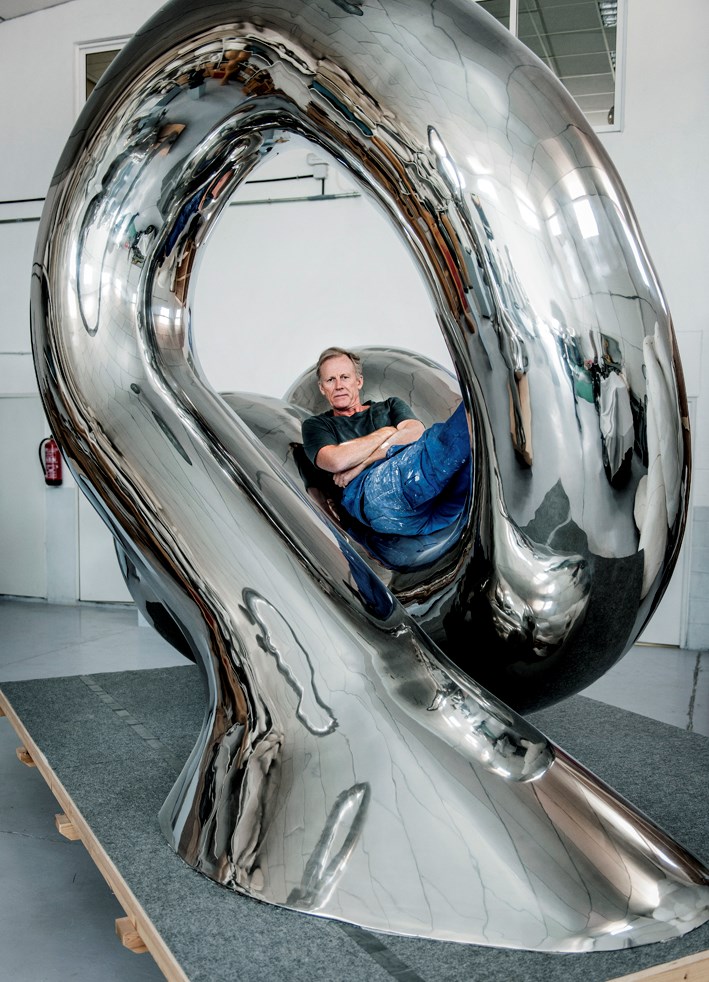Somewhere, on a ship in the middle of the Atlantic Ocean, halfway between Cape Verde and the coast of Brazil, Richard Hudson tried to touch the sky. Hudson was so struck by the beauty of both the sea and the sky that he grabbed a rope, tied it around his waist, and just jumped.
“I didn’t even think, said Hudson. It [was] just about how beautiful and big this world is.” The feeling of the ice-cold water hitting his skin was jarring, but it is always the artist’s quest for feeling, for sensory experience that motivates.
World-renowned contemporary sculptor Hudson’s series of polished, mirrored stainless steel sculptures invokes personal experience by putting the viewer at the forefront of the experience. Looking at a Hudson sculpture is an exercise in self-reflection. Examining the art makes you see yourself, and everything around you, with a panoramic precision.
Hudson, whose works are prominently featured in the private art collections of Prince Albert II of Monaco, Sir Elton John, Baron Bentink-Thyssen and Claudia Schiffer, made his Canadian debut this summer at the Parq, bringing installations that included his famed Tear, and Love Me. Another replica of Tear sits in New York outside Madison Square Garden, and yet another in London.
Here in Vancouver, Hudson made an impression. The first person who saw Tear bought it for over asking price ($300,000): local businessman Roger Hardy of Hardy Capital.
Hudson’s great influencer was his Mother, an artist, who left architectural college abruptly just prior to the Second World War to work for the government in decoding. She never told her children what she actually did, but they knew her work helped with the war effort. Growing up on a farm in Gloustershire, England, Hudson’s mother taught him to see what other people don’t.
“She taught me – when you’re walking down a country lane, don’t just look at the hedge, look inside the hedge. Look at the animals, and all those wonderful things. She taught me to really open my eyes to the whole world, and the nature of things,” Hudson said.
Entering adulthood, Hudson wouldn’t find his calling as a sculptor until his forties. First, he would experience a series of international adventures, including an attempt at acting. Hudson got into drama school, but that didn’t last long.
“I made a fool of myself by saying to the principal in a discussion about theatre, that I just wanted to be a cowboy in the movies,” Hudson said with a laugh. “I was always very protective of my freedom. I was never really interested in making huge sums of money – I just wanted to travel and see the world.”
So Hudson set off, travelling to Africa, Australia, America, and all over Europe. Even though Hudson hadn’t been an artist before, his brother had serendipitously gifted him sculpting tools before his trip.
“That was the one thing I had always loved in school – I was useless at all things academia,” Hudson said.
During his travels, Hudson became a muse to a painter in Mallorca, Spain. He rented a studio in a village in the mountains near Mallorca, and started experimenting by making sculptures with clay. An art gallery owner happened by, and was so struck by Hudson’s work that he flew him to Madrid the next day to discuss casting the clay sculptures in bronze.
Hudson’s first show sold out, and then he started exhibiting with top sculptors in the world. In 2008, Sotheby’s London Art department commissioned a piece in their Beyond Limits exhibition, and the first piece sold was the heart-shaped Love Me. A version of that sculpture sits in the park at the Donum winery in Napa Valley, and another sits outside the Burj Khalifa in Dubai. The heart-shaped Love Me sculptures are, as Hudson explained, renditions of the raw emotions inherent to the human experience.
“I wanted to add another dimension to the heart that shows something else. I thought of conception, of female and male, the pregnant woman. And the male, in an abstract, simplified form. That’s how it developed, aesthetically, and it’s been a hugely successful work. I love that people can look at these things and draw just their own conclusions,” Hudson said.
The iconic Tear, Hudson explained, simply represents water, but in many forms.
“We have tears of joy, and tears of sadness. Again, with reflective surface, I want people to look at it all the way round. You get a huge view of everything all around you, if you just take your eye – and think how much you’re looking at everything,  from the plants to the lights, everything – in just one split second, in the blink of an eye.”



